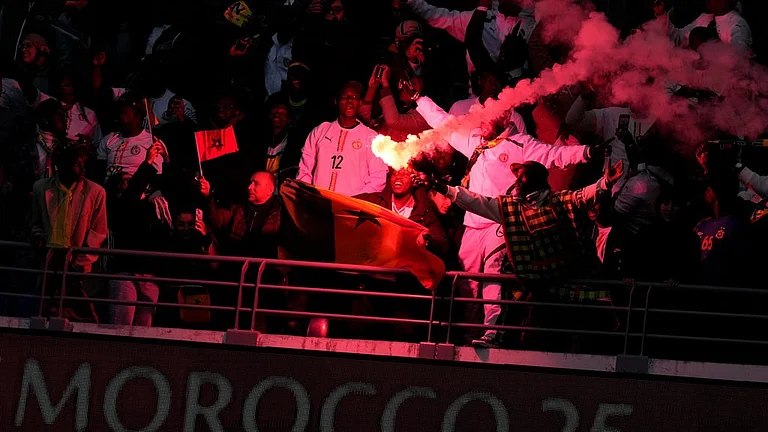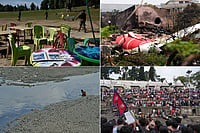It is early autumn morning; the smell of budding frangipani flowers lingers in my brain, bringing back recollections of carefree childhood revelries in Calcutta. I get ready to fly out to Africa, to the Niger Delta, an exquisite and proud land of sub Saharan music. Afrobeat freely mixes in the palette of my mind, with the hypnotic vibrations of the Dhak, embodying the nirvana of my youth: the festival of Durgotsava, a tumultuous experience characterised by a force-field of bliss. It begins with a Proustian ‘madeleine’ moment. The awnings of dawn are outside my plexiglass, sunrays slant in. I hark back to a similar daybreak in my childhood, an annual event that presaged Durga Puja. Woken up each year by my grandmother, as if by clockwork, on this auspicious day of Mahalaya, we listen to the sonorous rise and fall of Birendra Kishore Bhadra’s voice through All India Radio’s morning broadcast of Mahishasurmardini—an oratorio announcing the arrival of goddess Durga and her battle with the forces of evil. It floats in the early morning sky, foretelling a month of celebration. The crescendo of the Sanskrit chants stir emotions vividly, and somewhere over the Sahara I shapeshift into a frenzied Dhunuchi pirouette in late ’80’s Calcutta. A time of simplicity, strong community bonds, of joys and sorrows shared across class, material and religious divide.
Sounds and images of my neighbourhood puja celebration fill my brain. I picture utopia in logs of bamboo lying unfettered across the street corner a month before the pujas, waiting to be built into pandals; in people perfecting their craft (plays, song, dance, recitation and even magic shows), in time for the puja’s cultural component; organising committee members trooping into our house to discuss the varied nuances of the festivities, through cups of hot tea and gales of laughter. I remember, too, the carefree abandon of students at school with the steady approach of the pujas; the thump and thwack of ball upon bat as youths enjoying their Puja holidays play cricket on a late weekday morning; the growth of shoppers across the city as the pujas draw near. And the weightless, buoyant expectancy in the air, the choked lull before the dam breaks.
As the wide-body superjumbo passes through time zones, I build monuments of reminiscence. The offering of food to the mother goddess, an age-old tradition known as bhog, the traditional repast at noontime, is as much about faith as it is about the fun of eating (with multitudes). It’s simple fare—primarily a khichuri of lentils and rice, along with a mash of potatoes and greens such as peas, carrots, cauliflower and cabbages. In the community hall, this modest lunch takes the shape of a glorious feast and food is offered across the city without discrimination. Bhog was typically eaten on banana leaves, the food ladled out from buckets of galvanised metal. By the time bhog is over, the direct rays of the sun incline into early evening. Snaking queues offer a glimpse into the popularity of the neighbourhood puja; indeed, a lot of pride is invested into it.
I look down from my seat, a bird’s eye view of the world passing us by at subsonic rapidity, as I teleport myself to the profligacy of time during this festive week, when each second feels like a minute. It is a time for friendships, forged amongst the fires of Ma Durga’s sacrificial pyres. The youth congregate in the temples of unspoken communion. The pandals—where boys and girls brush past each other, intoxicated by the allure of minds and bodies—are groves of at-first-sight, budding love. Petty notions of morality are cast aside and acceptance rules the city. Such love usually lasts the duration of the pujas, but heartbreaks aren’t uncommon.
My mind flashes farther back into the past. I evoke the inimitable, ceremonious worship of the mother goddess during Pushpanjali. Past, present and future coalesce into one. Dressed in starched clothes, torn petals of flowers raining down amidst the chanting, I stare hypnotised, the idols’ eyes cesspools of consent.
I am flying cattle class, hemmed in by people. I recall the crowds attending the idols’ immersion at city pools. Packed shoulder to shoulder, crowds multiply in binary fission. A melee of limbs reaches out to touch the deity one last time before it dissolves into earth and water. The dhak’s beats rise to a furious pitch; the circling dhakis are dancing dervishes; the smell of camphor pervades the fabric of my very being. Amidst this heady tumult, I find myself desolate and lonely, overcome with a peaceful melancholy.





















